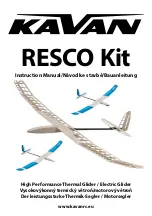
THRUSH AIRCRAFT, INC – MODEL S2R-R1340
AIRCRAFT MAINTENANCE MANUAL
Effective: 01/01/08
2-9
CARBURETOR IDLING MIXTURE:
With
engine at 450-600 RPM, check mixture
strength as follows:
a. While observing tachometer, slowly
move mixture control towards the FULL
LEAN position. Return mixture control
to the FULL RICH position before
engine dies.
b. If a momentary rise of not more than 20
RPM is observed before normal drop-
off, the mixture ratio is correct. If a
greater rise in RPM is noted, the
mixture is too rich. If no rise in RPM is
noted or an immediate drop-off in RPM
occurs, the mixture is too lean.
ENGINE SHUTDOWN:
To perform
engine shutdown, proceed as follows:
a. Adjust throttle to 1500 RPM, idle
engine for a minimum of one minute to
cool engine.
b.
Move propeller control to HIGH
PITCH/LOW RPM, and move throttle
to the IDLE position. Place mixture
control to FULL LEAN.
c. Open throttle slowly, continue opening
throttle slowly after engine starts to cut-
off, to full open throttle position.
d. After propeller stops turning, position
ignition switch to off.
e. Place fuel selector to OFF position,
place battery and generator switches to
OFF position.
SYSTEM AND COMPONENT
SERVICING
Servicing procedures contained in this
Section are confined to those maintenance
actions that occur with routine frequency
and require a reasonably short period of
time to accomplish. Servicing practices
and maintenance of aircraft systems and
components that require less frequent
attention are contained in the appropriate
sections of this manual.
HYDRAULIC SYSTEM
Reference Section 3
The hydraulic system consists of two
master brake cylinders and the necessary
hydraulic lines connecting the master
cylinders to the wheel brake cylinders.
Applying toe pressure to the rudder pedal
actuates the corresponding master
cylinder, which in turn actuates the brake
caliper piston. Refer to Section Six for
brake servicing procedures.
ENGINE OIL SYSTEM
Reference Section 4
The oil supply should be checked before
each flight (R-1340-AN1 engine, do not
operate with less than four gallons). Fill to
nine gallons for extended flights. Access
to the filler cap is gained through an
opening located on the top left side of the
fuselage cowling. Add oil that is of the
same quality and weight as that contained
in the oil tank. As a general rule, good
quality mineral base oil (60 weight
summer, 50 weight winter) is adequate.
For the use of approved types of
dispersant oil, refer to the applicable
Engine Manufacturers Service Bulletins.
OIL CHANGE:
The
frequency
of
engine lubricating oil change will vary
depending upon the type, and condition, of
engine operation. It is recommended that
the engine lubricating oil be changed at the
maximum of 50 hour intervals, and more
frequently as working conditions require.
Oil that becomes dirty and contains sludge
deposits should be changed regardless of
time since last oil change. To change oil,
proceed as follows:
a. Start engine, and operate until a
minimum of 40ºC (105ºF) is reached.
b. Place a container having a capacity of
12 gallons or more beneath oil drain
valve. Attach a hose to drain valve to
minimize oil spillage.
c. Open drain valve and allow engine oil
to drain thoroughly. Allow adequate
















































